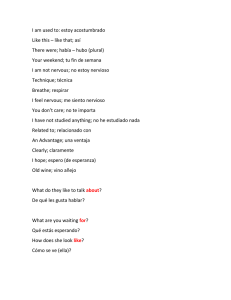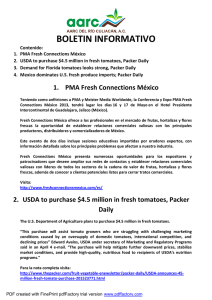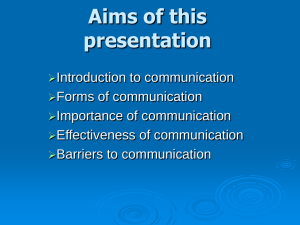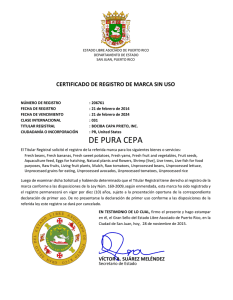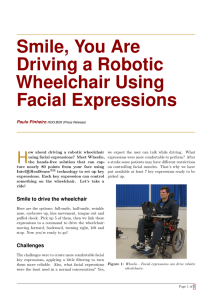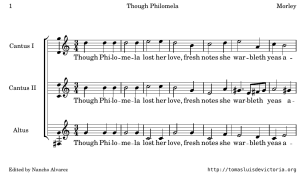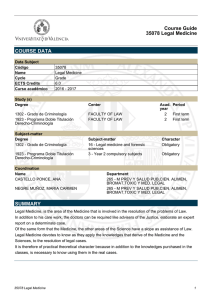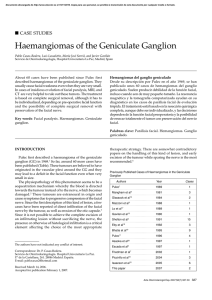Comparisons in Soft-Tissue Thicknesses on the Human Face in
Anuncio
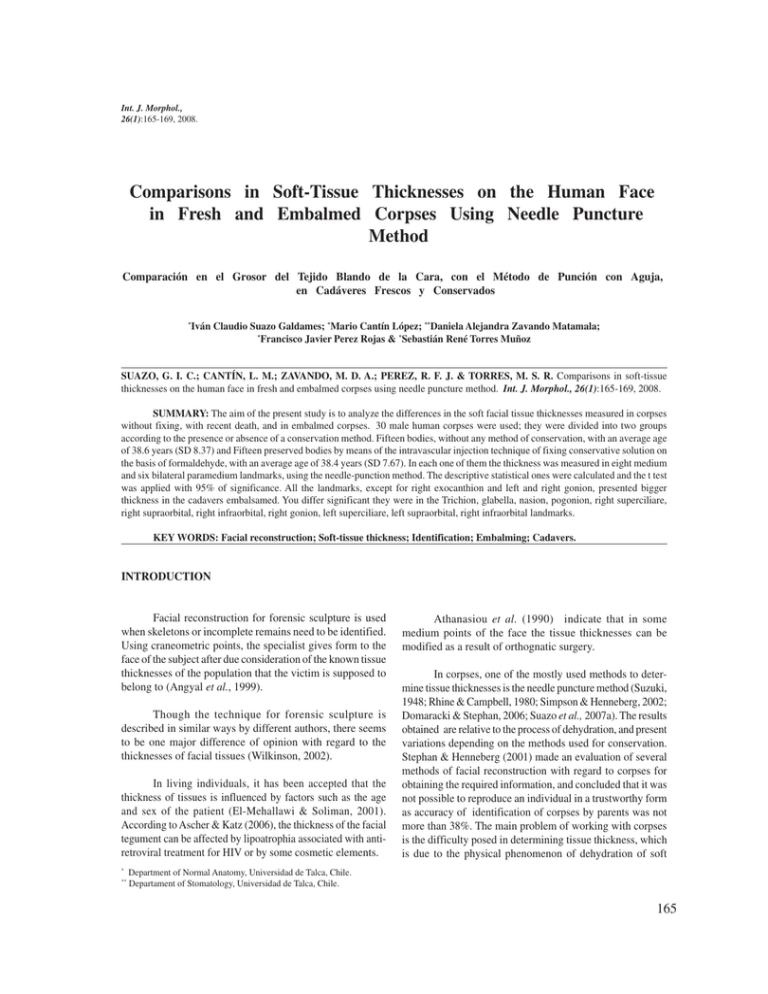
Int. J. Morphol., 26(1):165-169, 2008. Comparisons in Soft-Tissue Thicknesses on the Human Face in Fresh and Embalmed Corpses Using Needle Puncture Method Comparación en el Grosor del Tejido Blando de la Cara, con el Método de Punción con Aguja, en Cadáveres Frescos y Conservados * Iván Claudio Suazo Galdames; *Mario Cantín López; **Daniela Alejandra Zavando Matamala; * Francisco Javier Perez Rojas & *Sebastián René Torres Muñoz SUAZO, G. I. C.; CANTÍN, L. M.; ZAVANDO, M. D. A.; PEREZ, R. F. J. & TORRES, M. S. R. Comparisons in soft-tissue thicknesses on the human face in fresh and embalmed corpses using needle puncture method. Int. J. Morphol., 26(1):165-169, 2008. SUMMARY: The aim of the present study is to analyze the differences in the soft facial tissue thicknesses measured in corpses without fixing, with recent death, and in embalmed corpses. 30 male human corpses were used; they were divided into two groups according to the presence or absence of a conservation method. Fifteen bodies, without any method of conservation, with an average age of 38.6 years (SD 8.37) and Fifteen preserved bodies by means of the intravascular injection technique of fixing conservative solution on the basis of formaldehyde, with an average age of 38.4 years (SD 7.67). In each one of them the thickness was measured in eight medium and six bilateral paramedium landmarks, using the needle-punction method. The descriptive statistical ones were calculated and the t test was applied with 95% of significance. All the landmarks, except for right exocanthion and left and right gonion, presented bigger thickness in the cadavers embalsamed. You differ significant they were in the Trichion, glabella, nasion, pogonion, right superciliare, right supraorbital, right infraorbital, right gonion, left superciliare, left supraorbital, right infraorbital landmarks. KEY WORDS: Facial reconstruction; Soft-tissue thickness; Identification; Embalming; Cadavers. INTRODUCTION Facial reconstruction for forensic sculpture is used when skeletons or incomplete remains need to be identified. Using craneometric points, the specialist gives form to the face of the subject after due consideration of the known tissue thicknesses of the population that the victim is supposed to belong to (Angyal et al., 1999). Though the technique for forensic sculpture is described in similar ways by different authors, there seems to be one major difference of opinion with regard to the thicknesses of facial tissues (Wilkinson, 2002). In living individuals, it has been accepted that the thickness of tissues is influenced by factors such as the age and sex of the patient (El-Mehallawi & Soliman, 2001). According to Ascher & Katz (2006), the thickness of the facial tegument can be affected by lipoatrophia associated with antiretroviral treatment for HIV or by some cosmetic elements. * ** Athanasiou et al. (1990) indicate that in some medium points of the face the tissue thicknesses can be modified as a result of orthognatic surgery. In corpses, one of the mostly used methods to determine tissue thicknesses is the needle puncture method (Suzuki, 1948; Rhine & Campbell, 1980; Simpson & Henneberg, 2002; Domaracki & Stephan, 2006; Suazo et al., 2007a). The results obtained are relative to the process of dehydration, and present variations depending on the methods used for conservation. Stephan & Henneberg (2001) made an evaluation of several methods of facial reconstruction with regard to corpses for obtaining the required information, and concluded that it was not possible to reproduce an individual in a trustworthy form as accuracy of identification of corpses by parents was not more than 38%. The main problem of working with corpses is the difficulty posed in determining tissue thickness, which is due to the physical phenomenon of dehydration of soft Department of Normal Anatomy, Universidad de Talca, Chile. Departament of Stomatology, Universidad de Talca, Chile. 165 SUAZO, G. I. C.; CANTÍN, L. M.; ZAVANDO, M. D. A.; PEREZ, R. F. J. & TORRES, M. S. R. Comparisons in soft-tissue thicknesses on the human face in fresh and embalmed corpses using needle puncture method. Int. J. Morphol., 26(1):165-169, 2008. tissues (10–18 g/day/ weight), besides that of rigor mortis that affects the muscle fibers (De Greef et al., 2006). Simpson & Henneberg referred to the effect of conservation processes on the facial tissue thickness in corpses., According to them, the thickness increases considerably with embalming and this effect is more pronounced during the first six months of the conservation treatment. The information was processed by the SPSS program for Windows 11.5, the descriptive statistics of the sample were calculated, and the t test was applied to independent samples (p <0.05). The aim of the present study is to analyze the differences in the soft facial tissue thicknesses measured in corpses without fixing, with recent death, and in embalmed corpses. MATERIAL AND METHOD In this study, 30 male human corpses, without scars or facial deformities, were used; they were divided into two groups according to the presence or absence of a conservation method. Group fresh corpses: Fifteen bodies of adult males, without any method of conservation, with an average age of 38.6 years (SD 8.37), normal body mass index (19.2– 24.8 kg/m2), and a duration of death time ranging between 3 and 24 hours (mean 12.65 hours, SD 7.645). Group of preserved corpses: Fifteen bodies of adult males, preserved by means of the intravascular injection technique of fixing conservative solution on the basis of formaldehyde, applied between 4 and 6 months before this study (mean 5.17 months, SD 0.71), with an average age of 38.4 years (SD 7.67), and a normal body mass index (18.5 to 24.6 kg/m2). The fresh corpses were measured in the medicolegal institute of Curicó, according to the existing legal regulations, while the preserved corpses corresponded to those of the anatomy laboratories of Universidad de Talca, Chile and Cardenal Herrera Valencia, Spain. In every corpse, eight medium points and six bilateral paramedium points were identified and marked (Fig. 1). Fig. 1. Medium and paramedium points identified and marked for the measurement of the tegument thickness by needle puncture method 1) Trichion, 2) Supraglabella, 3) Glabella, 4) Nasion, 5) A of Downs, 6) B of Downs, 7) Pogonion, 8) Gnathion, 9) Supraorbital, 10) Superciliary, 11) exocanthion, 12) Infraorbital, 13) Zygion, 14) Gonion. RESULTS The embalmed corpses presented major thicknesses of tissue in all sites, with the exception of the exocanthion right and gonion right and left points. The descriptive statistics of the measured facial tissue thicknesses of the fresh and embalmed corpses are shown in Table I. At each of these points, the measurement of the tegument thickness by needle puncture method described by His in 1895 (outlined in Krogman & Iscan, 1986) was performed. When we compared the mean obtained in each point in the fresh corpses with that of the embalmed corpses, the resulting differences are significant (p <0.05) for the trichion, glabella, nasion, pogonion, superciliary right, supraorbital right, infraorbital right, gonion right, superciliary left, supraorbital left, and infraorbital left points. The sample was analyzed by two observers and the level of conformity was calculated between them. A high level of conformity between observers was obtained (k =0.93). 166 SUAZO, G. I. C.; CANTÍN, L. M.; ZAVANDO, M. D. A.; PEREZ, R. F. J. & TORRES, M. S. R. Comparisons in soft-tissue thicknesses on the human face in fresh and embalmed corpses using needle puncture method. Int. J. Morphol., 26(1):165-169, 2008. Table I. Descriptive statistic of the facial thicknesses tissues on fresh and embalmed cadavers. TRICHION SUPR AGLABELLA GLABELLA NASION A OF DOWNS B OF DOWNS POGONION GNATHION RIGHT SUPERCILIARE RIGHT SUPRAORBITAL RIGHT INFRAORBITAL RIGHT EXOCANTHION RIGHT ZYGION RIGHT GONION LEFT SUPERCILIARE LEFT SUPRAORBITAL LEFT INFRAORBITAL LEFT EXOCANTHION LEFT ZYGION GROUP FRESH N MEAN TYPICAL DEVIATION TYPICAL ERROR 15 4.193 0.891 0.230 EMBALMED 15 4.953 0.440 0.113 FRESH 15 4.333 0.893 0.230 EMBALMED 15 4.546 0.399 0.103 FRESH 15 4.546 0.668 0.172 EMBALMED 15 5.446 0.623 0.160 FRESH 15 5.120 0.952 0.245 EMBALMED 15 6.066 0.335 0.086 FRESH 15 10.733 2.515 0.649 EMBALMED 15 11.533 0.833 0.215 FRESH 15 10.053 2.108 0.544 EMBALMED 15 10.740 0.567 0.146 FRESH 15 9.633 1.595 0.412 EMBALMED 15 11.340 0.547 0.141 FRESH 15 6.406 0.743 0.191 EMBALMED 15 8.066 1.486 0.383 FRESH 15 4.066 0.877 0.226 EMBALMED 15 5.806 0.382 0.098 FRESH 15 5.420 1.209 0.312 EMBALMED 15 7.160 1.301 0.336 FRESH 15 4.693 1.018 0.262 EMBALMED 15 5.840 1.439 0.371 FRESH 15 4.106 1.431 0.369 EMBALMED 15 4.066 0.457 0.118 FRESH 15 7.053 2.281 0.589 EMBALMED 15 7.773 3.061 0.790 FRESH 15 10.020 2.617 0.675 EMBALMED 15 7.533 2.825 0.729 FRESH 15 3.780 1.147 0.296 EMBALMED 15 5.820 0.536 0.138 FRESH 15 5.0466 1.210 0.312 EMBALMED 15 6.933 1.376 0.355 FRESH 15 4.440 1.267 0.327 EMBALMED 15 5.880 1.573 0.406 FRESH 15 3.346 1.698 0.438 EMBALMED 15 3.960 0.465 0.120 FRESH 15 6.540 1.225 0.316 167 SUAZO, G. I. C.; CANTÍN, L. M.; ZAVANDO, M. D. A.; PEREZ, R. F. J. & TORRES, M. S. R. Comparisons in soft-tissue thicknesses on the human face in fresh and embalmed corpses using needle puncture method. Int. J. Morphol., 26(1):165-169, 2008. DISCUSSION In facial reconstruction of forensic sculpture, it is necessary to know the thicknesses of the different points of the face; different authors have described these parameters in subjects from different ethnic groups by measuring the depth of the soft facial tissues in corpses using the needle puncture method (Suzuki; Rhine & Campbell; Simpson & Henneberg; Domaracki & Stephan; Suazo et al., 2007a); nevertheless, the effects of the processes of conservation have not been sufficiently studied. In our study we found major thickness in the preserved corpses in a majority of 20 analyzed points, and there were significant differences in 11 of them. This could be due to the dehydration that postmortem corpses suffer, as it was indicated by Phillips & Smuts (1996). Rhine & Campbell, on the other hand recommend the utilization of corpses without embalming because the distortions from the process of dehydration are major in increased duration after death. The increase in the tissue thicknesses in the preserved corpses in our study group could also be due to the accumulation of the conservation liquid in the facial tegument. According to Simpson & Henneberg, there was an initial increase in the thickness of the facial soft tissue between 50-60% in all the measured points, but after 6 months the thicknesses decreased by 20%; this finding was not corroborated in our study because the corpses presented a time of conservation of less than 6 months. The major thicknesses found in the gonion right and left points in fresh corpses can relate to the early formation of postmortem cutaneous folds determined by the rigor mortis. For Concha (1992) the formation of these folds impede the measurement of the tissue thickness pertaining to the jaw angle level. Our results indicate that for the process of facial reconstruction for forensic sculpture, the postmortem data and the use of the different methods of conservation of corpses must be considered when coming to conclusions regarding comparisons of facial tissue thicknesses arrived at by needle puncture on corpses and the measurements realized from information obtained about live subjects by means of radiograph, ultrasound, computerized tomography or nuclear magnetic resonance (Aulsebrook et al., 1995; ElMehallawi & Soliman; De Greef et al.; Vandermeulen et al., 2006; Suazo et al., 2007b). SUAZO, G. I. C.; CANTÍN, L. M.; ZAVANDO, M. D. A.; PEREZ, R. F. J. & TORRES, M. S. R. Comparación en el grosor del tejido blando de la cara, con el método de punción con aguja, en cadáveres frescos y conservados. Int. J. Morphol., 26(1):165-169, 2008. RESUMEN: El propósito de este estudio fue analizar las diferencias en el grosor tisular facial entre cadáveres frescos y conservados. Se utilizaron 30 cadáveres de sexo masculino, 15 de los cuales presentaron una data de muerte media de (SD) y los otros 15 fueron cadáveres conservados mediante inyección intravascular de solución fijadora conservadora en base a formol. En cada uno de ellos fueron medidos los grosores en 8 puntos medianos y 6 puntos paramedianos bilaterales, utilizando el método de punción con aguja. Se calcularon los estadísticos descriptivos y luego se aplicó el t test con un 95% de significancia. Todos los puntos, con excepción de Exocanthion derecho y Gonion derecho e izquierdo, presentaron grosores mayores en los cadáveres conservados. Diferencias significativas se encontraron en los puntos Trichion, Glabela, Nasion, Pogonion, Superciliar derecho, Supraorbitario derecho, Infraorbitario derecho, Gonion derecho, Superciliar izquierdo, Supraorbitario izquierdo, Infraorbitario derecho. PALABRAS CLAVE: Reconstrucción facial; Grosor de tejido blando; Identificación; Embalsamamiento; Cadáveres. REFERENCES Angyal, M.; Rimmer, E. & Vollmuth, K. Plastic facial reconstruction in forensic medicine. Orv. Hetil., 140(51):2865-8, 1999. and dentoskeletal profile changes associated with mandibular advancement osteotomy. Hell Period. Stomat. Gnathopathoprosopike Cheir., 5(4):157-63, 1990. Ascher, B. & Katz, P. Facial lipoatrophy and the place of ultrasound. Dermatol Surg., 32(5):698-708, 2006. Aulsebrook, W. A.; Is¸can, M. Y.; Slabbert, J. H. & Becker, P. Superimposition and reconstruction in forensic facial identification: a survey. Forensic Sci. Int.,75(2-3):10120, 1995. Athanasiou, A. E.; Gjorup, H. & Toutountzakis, N. Soft tissue 168 SUAZO, G. I. C.; CANTÍN, L. M.; ZAVANDO, M. D. A.; PEREZ, R. F. J. & TORRES, M. S. R. Comparisons in soft-tissue thicknesses on the human face in fresh and embalmed corpses using needle puncture method. Int. J. Morphol., 26(1):165-169, 2008. Concha, S. G. Estudio de las arrugas faciales en relación con su localización y manifestación según la edad. Tesis para optar al Título de Cirujano Dentista. Universidad de Chile, Santiago-Chile, 1992. De Greef, S.; Claes, P.; Vandermeulen, D.; Mollemans, W.; Suetens, P. & Willems, G. Large-scale in-vivo Caucasian facial soft tissue thickness database for craniofacial reconstruction. Forensic Sci. Int., 159 (1):126-46, 2006. Domaracki, M. & Stephan, C. N. Facial soft tissue thicknesses in Australian Adult Cadavers. J. Forensic Sci., 51(1):5-10, 2006. El-Mehallawi, I. H. & Soliman, E. M. Ultrasonic assessment of facial soft tissue thicknesses in adult Egyptians. Forensic Sci. Int., 117(1-2):99-107, 2001. Krogman, W.M. & Iscan, M.Y. The human skeleton in Forensic Medicine. Springfield, Illinois, Charles C. Thomas, 1986. reconstruction using CT-derived implicit surface representations. Forensic Sci. Int., 159 (1):164-74, 2006. Wilkinson, C. M. In vivo facial tissue depth measurements for white British children. J. Forensic Sci., 47(3):45965, 2002. Correspondence to: Prof. Dr. Iván Suazo Galdames Department of Normal Anatomy Universidad de Talca Lircay street s/n oficina N°104 Talca - CHILE Fone 56-71-201682 Email: isuazo@utalca.cl Received: 04-09-2007 Accepted: 11-01-2008 Phillips, V. M. & Smuts, N. A. Facial reconstruction: utilization of computerised tomography to measure facial tissue thickness in a mixed racial population. Forensic Sci. Int., 83:51-9, 1996. Rhine, J. S. & Campbell, H.R. Thickness of facial tissues in American Blacks. J. Forensic Sci., 24(4):847-58, 1980. Simpson, E. & Henneberg, M. Variation in soft-tissue thicknesses on the human face and their relation to craniometric dimensions. Am. J. Phys. Anthropol., 118:121-33, 2002. Stephan, C. N. & Henneberg, M. Building faces from dry skulls: are they recognized above chance rates? J. Forensic Sci., 46(3):432-40, 2001. Suazo, G. I. C.; Pérez, R. F. J. & Torres M. S. A. Grosores Tisulares Faciales en Cadáveres de Españoles y su Aplicación en la Identificación Médicolegal. Int. J. Morphol., 25(1):109-116, 2007a. Suazo, G. I. C.; Salgado, A. G. E. & Cantín, L. M. G. Evaluación ultrasonográfica del tejido blando facial en adultos chilenos. Int. J. Morphol., 25(3):643-8, 2007b. Suzuki, K. On the thickness of soft parts of the Japanese face. J. Anthropol. Soc. Nippon, 60:7-11, 1948. Vandermeulen, D.; Claes, P.; Loeckx, D.; De Greef, S.; Willems, G. & Suetens, P. Computerized craniofacial 169
